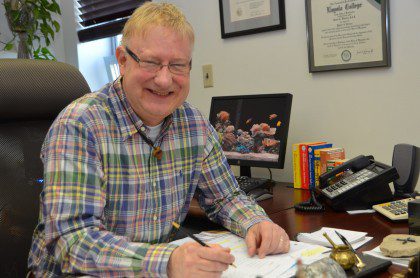
Concentrated course helps prepare students for the Church’s growing Hispanic population
Learning a new language as an adult is difficult. Going back to school after many years in the workforce is challenging. Discerning a call to ministry at the same time?
Very challenging!
Yet that is what many seminarians at Sacred Heart School of Theology do. Much of the student body consists of men who are pursing their vocation as an older adult. Most have been away from academic studies for years.
“We were concerned about students telling us that they did not have enough time to study Spanish during the school year,” said Fr. Jim Walters, SCJ. “Often, our students are required by their bishops or superiors to take Spanish. However, Spanish is not a part of the core curriculum. It is offered as a twice-a-week, two credit course. Our students feel pressure to put their energies into the core courses, the three-credit church and theology courses.”
In the midst of classes on Church history, scripture, and pastoral studies, seminarians often find it difficult to memorize irregular verbs in Spanish, “let alone try to come up with the Spanish word for eggplant,” said Fr. Jim.
The eggplant reference goes to the heart of Fr. Jim’s vision for how Spanish should be taught at the seminary.
“It needs to be practical,” he said. “Our goal is to help our students become pastorally fluent in Spanish.”
“Most introductory language programs are geared toward high school students,” he continued. “They have students memorize items in the classroom and the names of fruits and vegetables. But when is a person in parish ministry going to need to need to ask for an ‘eggplant’ in Spanish?”
Sacred Heart School of Theology was the first seminary in the country to establish a Hispanic Studies program; it was developed under the direction of Fr. Raul Gómez, SDS, in 1988.
Fr. Jim took it over in 2004. He came from a 25-year background in parish ministry, including many years in Hispanic ministry, as well as several years as a Spanish instructor.
“One of the first things I asked myself was ‘What would be most useful to know as a parish minister?’” said Fr. Jim.
He, and members of the Hispanic Studies Advisory Committee, asked themselves how they could better teach Spanish to those preparing for parish ministry.
The committee started with a survey in 2010. Responding to it, many students echoed concerns that Fr. Jim had heard already: it was hard to devote adequate attention to Spanish studies in the midst of a full load of core seminary classes.
The solution? Offer Spanish at a time when students can fully devote themselves to learning the language. The seminary had a five-week May session. During it, students generally took one or two concentrated versions of a three-credit course.
“We asked if there would be interest in a May session devoted to Spanish,” said Fr. Jim. There was, and so the Hispanic Studies Department developed a proposal that went before the Academic Advisory Council. The proposal was approved on a trial basis.
“We are holding the session for the first time this year, ad experimentum,” said Fr. Jim.
This is the first time that an elective course is being taught during the May session. A time-intensive program, those taking part in it will not be allowed to take any other classes in the May session. The five-week course, “Intensive Intermediate Spanish,” will be the equivalent of two intermediate Spanish classes.
Since it is a program geared toward preparing students for use of Spanish in a pastoral setting, first on the schedule each day will be prayer, in Spanish. The morning sessions will be devoted to grammar and structure. Sr. Susan Klein, OP, a member of the Hispanic Studies Department, will teach these.
At 11:00, the class will break for Mass –– again, in Spanish –– before heading to “almuerzo,” or lunch, in Spanish. Then it’s Fr. Jim’s turn. In the afternoon session he will work on the “practical application of the language,” he said. “We will do conversational exercises, dialogues, role-playing, homilies, scripture reflections and other parish-based applications.”
Teaching in tandem will be “the most challenging part of the project,” he added. When an instructor is working independently he or she can adjust the schedule or syllabus as needed. “Some days you can’t accomplish everything that you planned on.”
Fr. Jim and Sr. Susan will meet each day to touch base “so that I can adapt the afternoon session depending on how the morning class went.”
On the weekends, students will watch Spanish language movies. First, they will see them with English subtitles. “Then we will watch it again without the subtitles so that the students can try to hear the words,” said Fr. Jim.
Ten students are registered for the inaugural May session. Two are priests (including one SCJ on sabbatical from another country), six are seminarians, one is an SHST faculty member and one is a lay pastoral minister from the Archdiocese of Milwaukee. At the end of the session students and teachers will evaluate the experience to help determine if the experiment will become a regular part of the academic calendar.
“Since we will still offer the two courses that this May session covers my suggestion will most likely be to offer the intensive program every other year,” said Fr. Jim. “But we will have to see how the next five weeks go.”
The May session begins on May 15 and runs through June 15.
